Calathea, also known as Goeppertia, is a houseplant well-known for its attractive and decorative leaves. It is an herbaceous perennial plant from the Marantaceae class. There are different types of calathea plants, which are unique in their own right, but all in one family.
Regardless of the calathea variety, they all require similar care for healthy growth. They thrive best in rich, well-draining soil, moderate to high humidity, and warm habitats with bright indirect sunlight.
With their vibrant and exotic foliage, it’s easy to fall in love with calatheas – and in today’s post, we’re going to show you some of the most stunning varieties of calatheas that you can add to your houseplant collection.
Table of Contents
What is Calathea Plant?
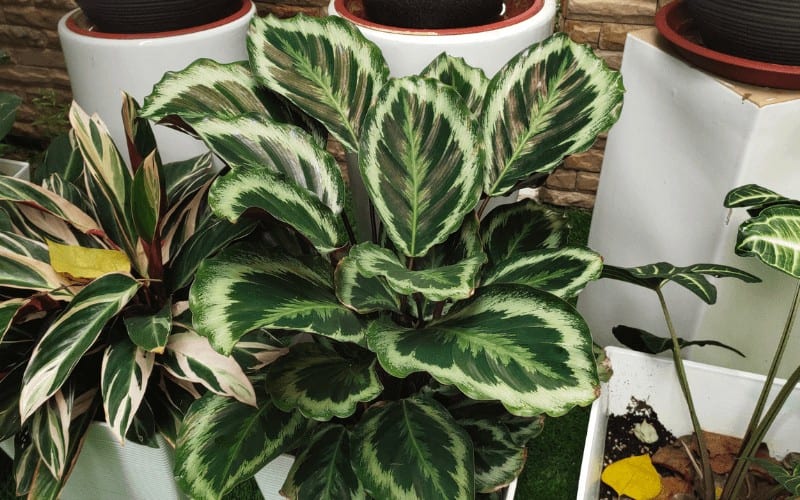
Calathea is a popular houseplant that is native to the tropical areas of America, Brazil and Colombia to be precise. Its specie name was coined from the Latin word, ‘Calathus’ meaning ‘basket’.
This name was given to it based on the idea that its flowers bear a resemblance to flowers in a basket.
Calathea plants has many beautiful features including leaves that are wide and long. They may also be able to sport stripes and other markings in shades of green, maroon, purple, and cream.
A good number of the calathea plant types possess leaves that covers itself towards the evening periods, which is why it’s been referred to as, ‘Prayer Plants’, then reopens at the dawn of a new day. This process is known as Nysctinasty.
It stands at 1’ to 3’ feet with an equal spread. Meanwhile, it is winter hardy in USDA hardiness zones 11 through 12.
It is also known to be a seasonal bloomer that produces flowers in shades ranging from white to purple. Calathea plant possesses an extremely beautiful, decorative evergreen foliage.
All the above features, coupled with the fact that its maintenance is not by no means difficult, neither is it complicated makes the calathea plant so popular and appealing, especially for gardeners.
Nevertheless, we have been able to draw a list of the various types of calathea plant. So, it is now left for you to choose from and make your home alluring and adorable with this houseplant.
What is Calathea Used For?
Calathea, like we earlier mentioned, is a group of well-known houseplants, hence, is mostly planted as a decorative plant for indoor use.
Nevertheless, if you insist on using it outdoors, you must ensure that the area has a tropical or semi-tropical setting.
That said, let’s quickly run you through the different calathea varieties so you will know which of them is more suitable for your home and garden.
Types of Calathea Plants
1. Rattlesnake Plant (Calathea Lancifolia)
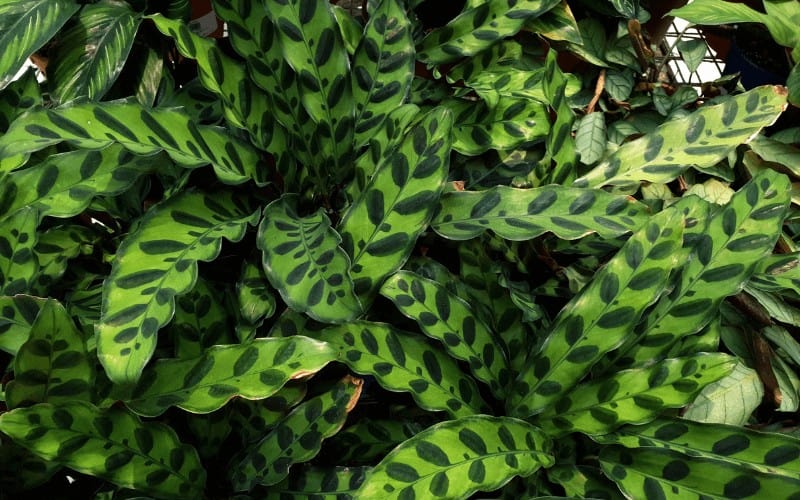
The above type is a very well-known plant that possesses features like narrow, long leaves in shades of light and dark green.
Its background leaves are light green in color, while its amazing markings are made up of darker green shades.
2. Pinstripe Calathea (Calathea Ornata)
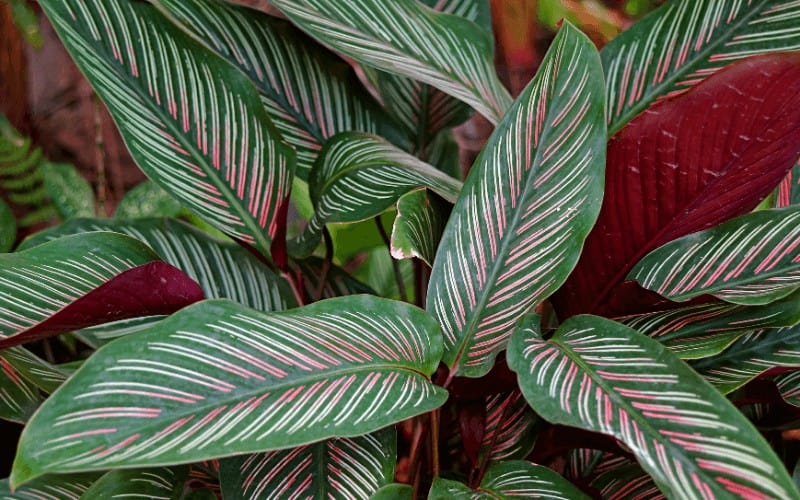
This type of Calathea features a tall, appealing plant which possesses green leaves that measures at about 12” inches long.
It also has amazing leaves that are marked with bright, pinkish-white stripes. The long stems, meanwhile, are a medium shade of burgundy.
3. Round-Leaf Calathea (Calathea Orbifolia)
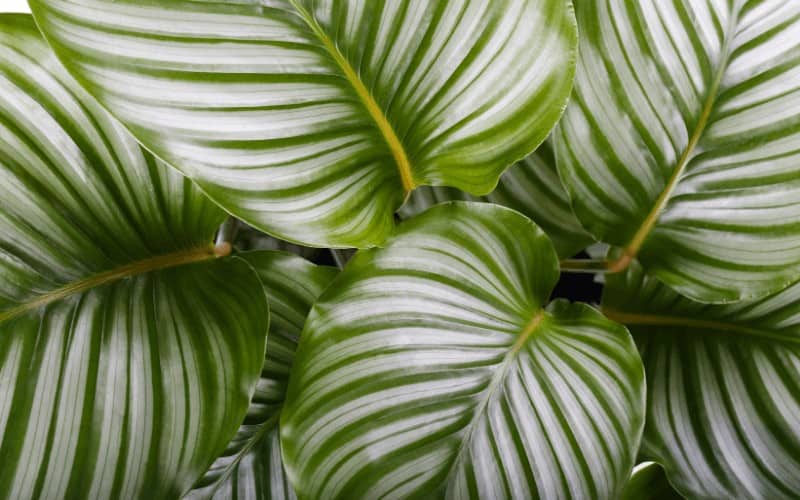
This type of calathea consist of 8–12-inch wide, leathery leaves with creamy and light-green stripes. It is best in humid conditions and well-draining soil.
That said, you want to make sure the plant is kept under partial shade.
4. Furry Feather (Calathea rufibarba)
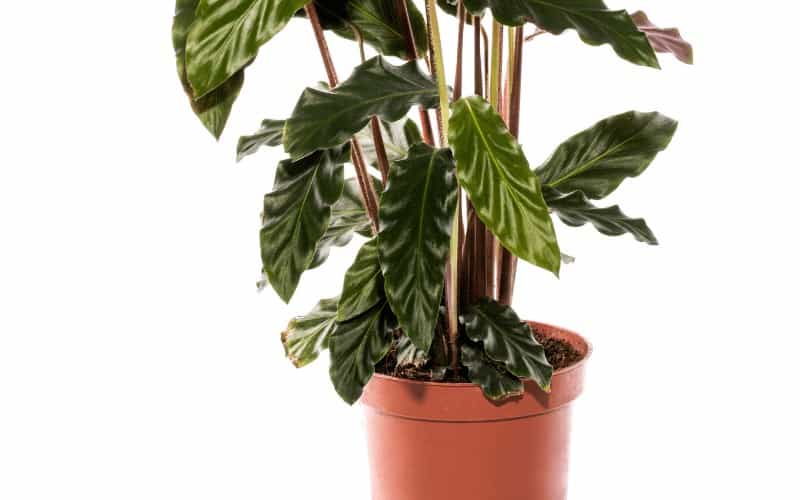
Another name for this amazing plant is velvet calathea. It features a lance-shaped green foliage, with velvety purple undersides on long burgundy stems.
It prefers to be kept in lower light conditions.
5. Corona (Calathea roseopicta)
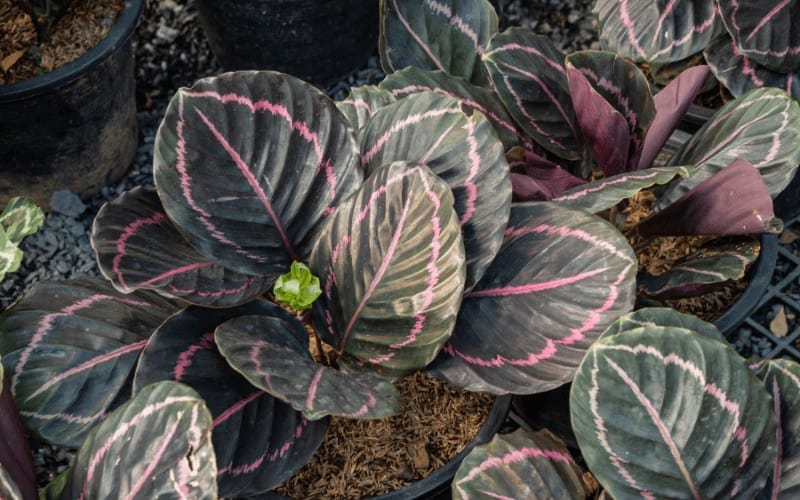
Corona or Rose painted calathea, like it is popularly called, possesses a large glossy foliage with bright green to creamy patterns.
It thrives best in well-draining soil. Ensure it is been protected from cold drafts.
6. Peacock Calathea (Calathea Makoyana)
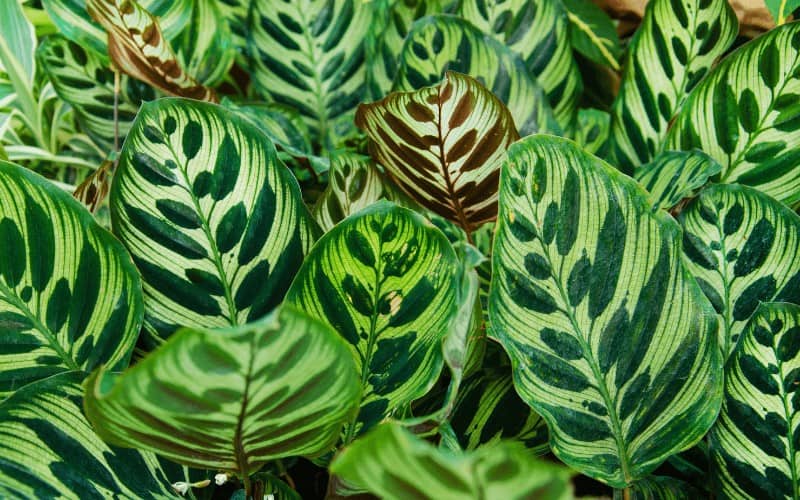
It can also be called Cathedral Calathea. It has leaves that are quite thin, and grow in attractive shades of deep green and purple with lime green markings.
The patterning on the leaves bears the resemblance of a peacock feather, so it is no surprising it is named after a peacock.
Meanwhile, it is a beautiful plant that needs to remain in a setting that has very bright indirect sunlight, as well as very high humidity.
7. Calathea Medallion (Calathea Veitchiana)
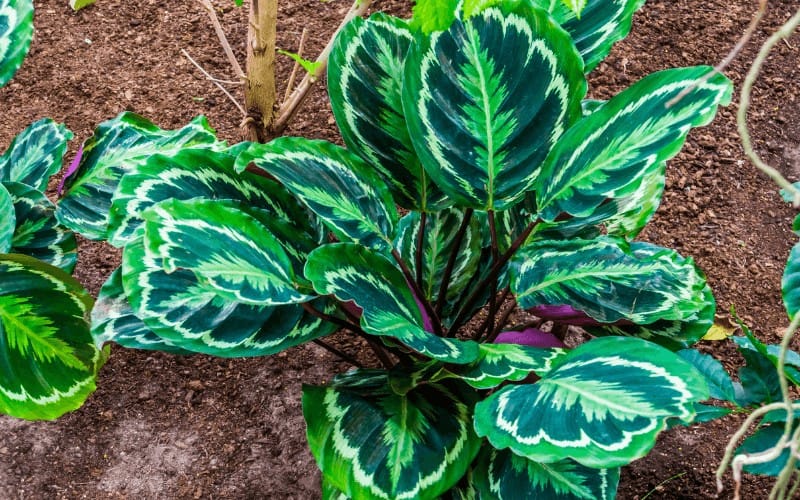
This calathea variety possesses a very large, oval-shaped leaves in shades of deep green on the top and deep purple underneath.
The top side of the oval leaves has a feathery center and verge of medium olive green. The feather-shaped center marking is surrounded by darker green with an outline of cream.
8. Jungle Velvet (Calathea Warscewiczii)
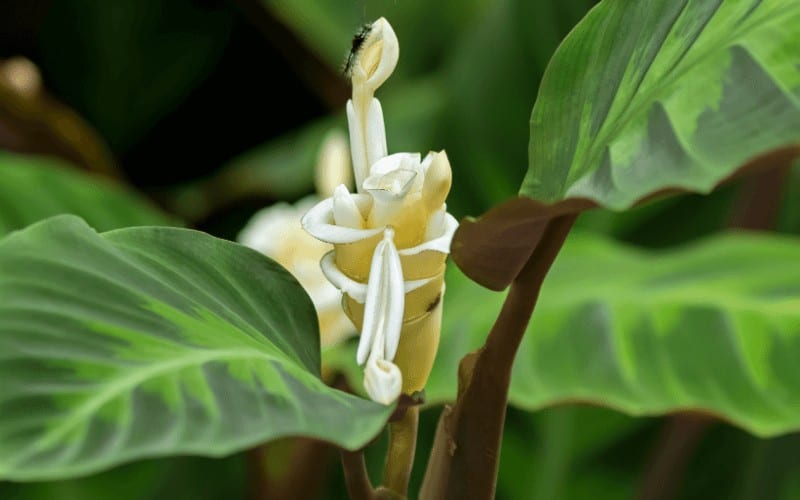
This type of Calathea can be gotten from the jungles of Nicaragua and Costa Rica, little surprising it goes by the name, ‘Jungle Velvet’.
The plant possesses a lance-shaped, deep green, velvety leaves with a lighter green leaf pattern.
This particular type demands a high level of humidity, while the application of a plant humidifier is also very much required.
9. Dottie (Calathea roseopicta ‘Dottie’)
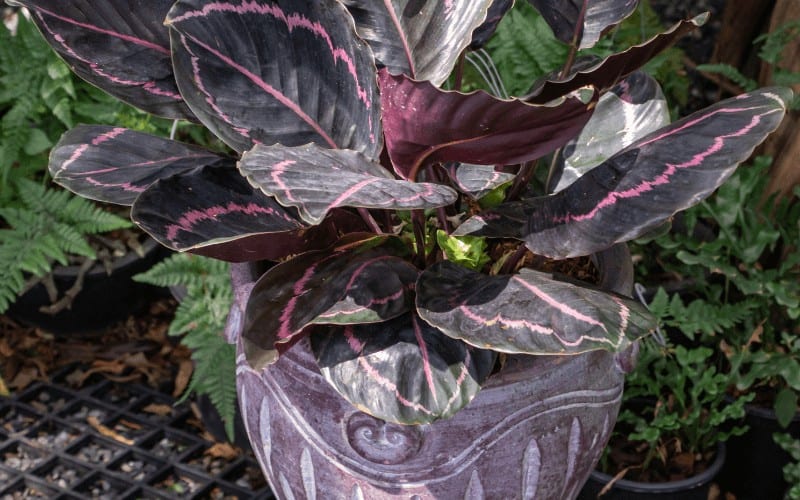
This calathea plant type features a deep-green foliage that is almost black, with fuchsia pink outlines on each leaf.
It grows best when kept in bright, indirect sunlight and mist regularly to maintain humidity.
10. Rosey (Calathea roseopicta ‘Rosey’)

This variety comes with a large oval-shaped leaf with green edges and a pink center with purple undersides that fold during the night.
Therefore, it is advisable you grow it in a well-draining soil, and ensure you protect it from cold drafts.
11. Velvet or Furry Calathea (Calathea Rufibarba)
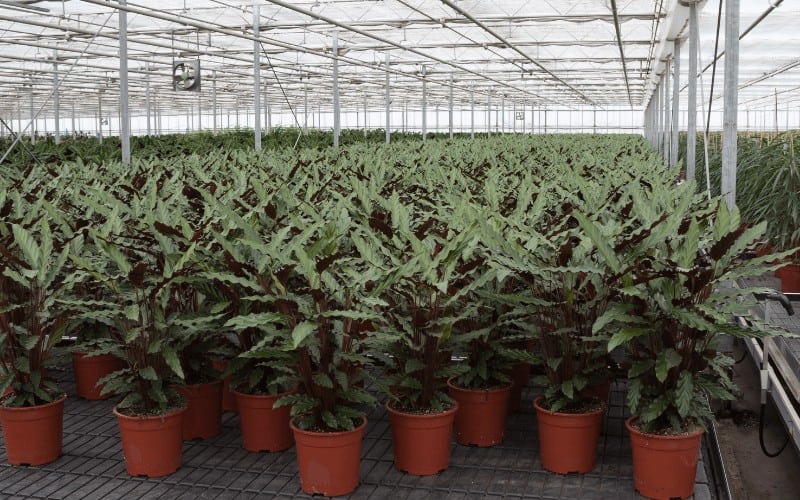
This particular species is very popular, and comes with lance-shaped leaves that are green on the top and purple and fuzzy underneath. The stems are a kind of long and are deep burgundy in color.
Nevertheless, the Furry Calathea thrives best when grown in a low light setting. Hence, you should take note of it, to ensure its beauty remains, while also preventing it from fading away.
12. Calathean Leopardina (Calathea Concinna)
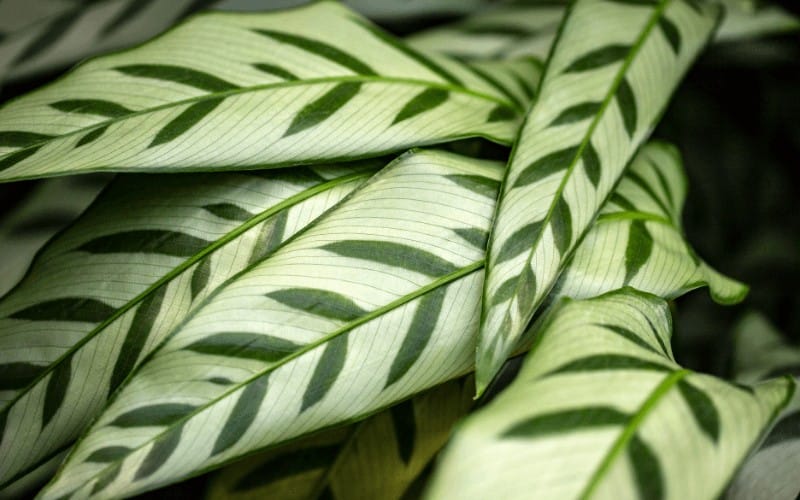
You can hear most people call it “zebra plant” most times. This is due to the fact that, the markings on it bears the resemblance of Zebra print.
It carries a long, lance-shaped leaves that are light green, with deep green, leaf-shaped markings radiating from the central vein. The leaves stand on the top of long, light green stems.
Before a year runs by, Calathea Leopardina blooms white flower repeatedly. It is a very beautiful plant that attracts birds, bees and butterflies.
This plant is a perfect groundcover and for indoor use. Meanwhile, it needs steady watering. It is advisable that you don’t allow the soil to ever dry out between watering.
13. Sanderiana (Calathea ornata ‘Sanderiana’)
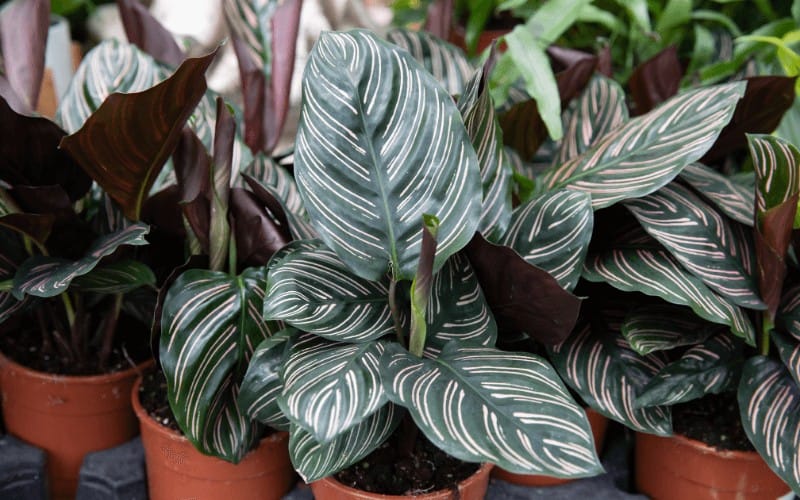
Sanderiana features a glossy dark-green leaves with rose-cream pinstripes and purple bottom sides.
The plant is at its best when kept in indirect sunlight, therefore, ensure it remains in a bright spot.
14. Calathea Freddie (Calathea Concinna 'Freddie')
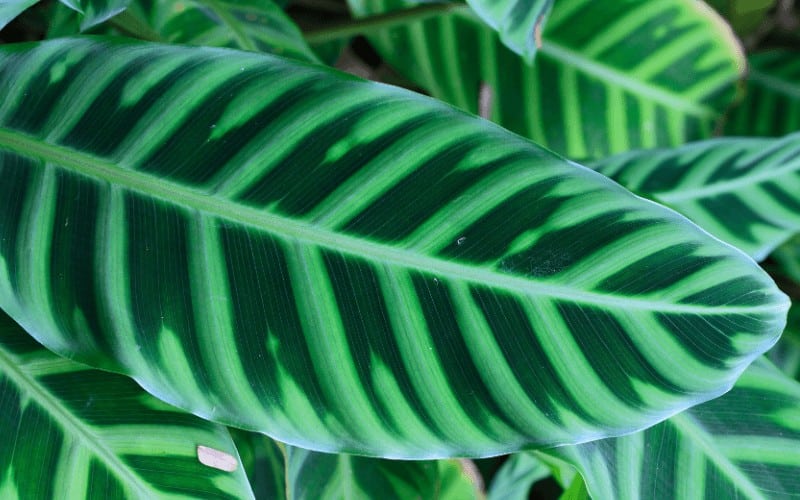
This type of Calathea plant looks quite astounding with its light green and long narrow leaves patterned with dark-green feathery veins.
The plant is at its best when placed in bright indirect light. Those are the guidelines you need to take in order to ensure and maintain proper humidity.
15. Eternal Flame (Calathea Crocata)
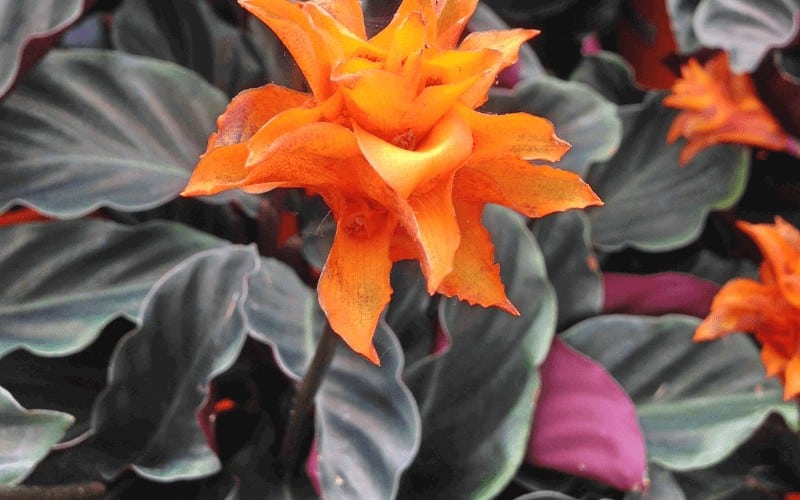
The Eternal Flame plant, as it is commonly called, is a Brazilian plant that possesses dark green, lance-shaped, ruffled leaves that are most importantly, long-lasting and very beautiful with the plants’ unusual yellow orange flowers.
It is at its best with high degrees of very bright indirect sunlight. As a matter of fact, it is most lovely when exposed to an almost direct morning sunlight.
16. Never Never Plant (Calathea Lubbersiana)
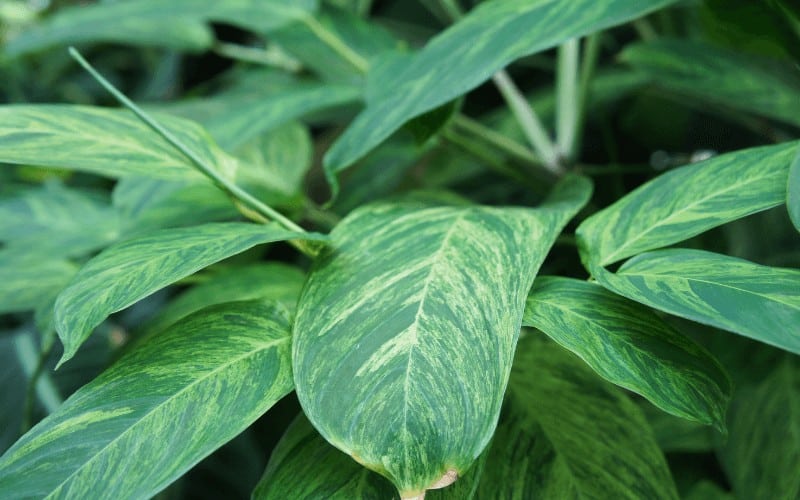
Popularly known as “never plant,” Ctenanthe Lubbersiana originated from Brazil. It features alluring beautiful, variegated leaves in shades ranging from very deep green to very bright yellow.
This plant flourishes best when planted in a favorable humidity condition, and should be exposed to a certain degree of indirect sunlight.
17. Calathea Oppenheimiana (Ctenanthe Oppenheimiana)
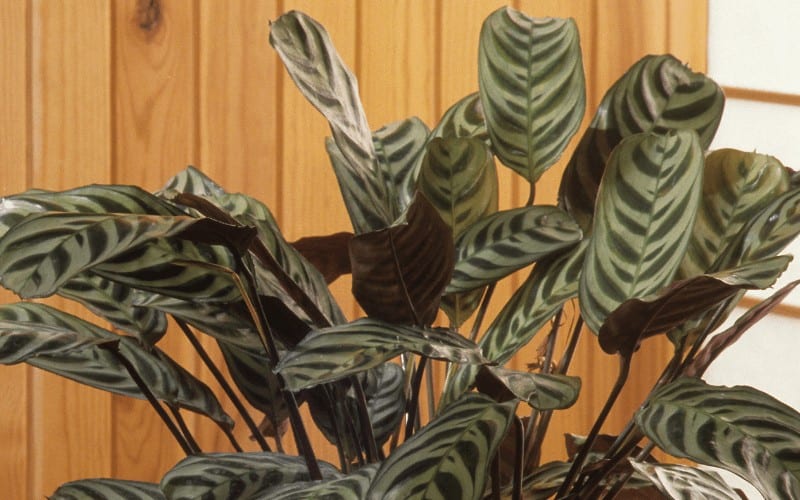
This Calathean variant is native to Brazil. It features long, leathery leaves of deep, luminous green, striped, and patched at the top in white and pink. Underneath it, is colored deep wine.
On its tender leaves, the color radiates through to give a red glow. It is a plant that is so attractive that it can be used as a table centerpiece.
18. Network™ Calathea (Calathea musaica ‘PP0005’)
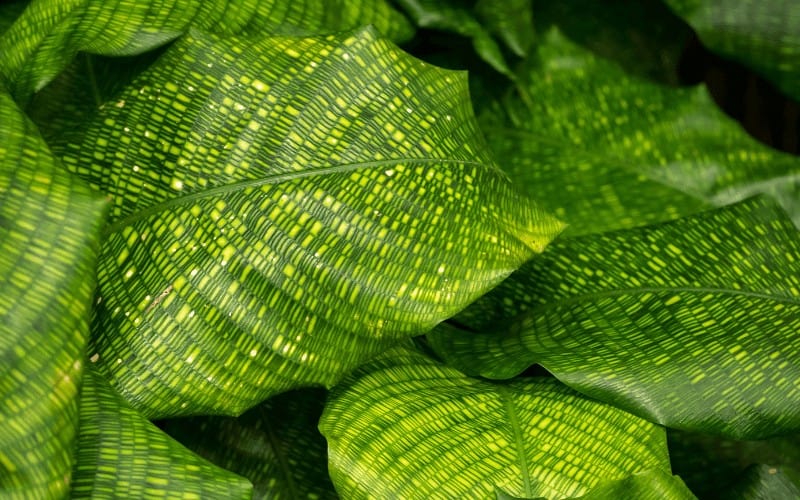
What a stunning plant this is! It is an incredible textured cultivar that features variegated small green leaves.
The plant is at its best when placed in bright indirect light. In other words, placing it by the East or West window is very much recommended for its safety and constant attractiveness.
19. Fusion White (Calathea ‘Fusion White’)
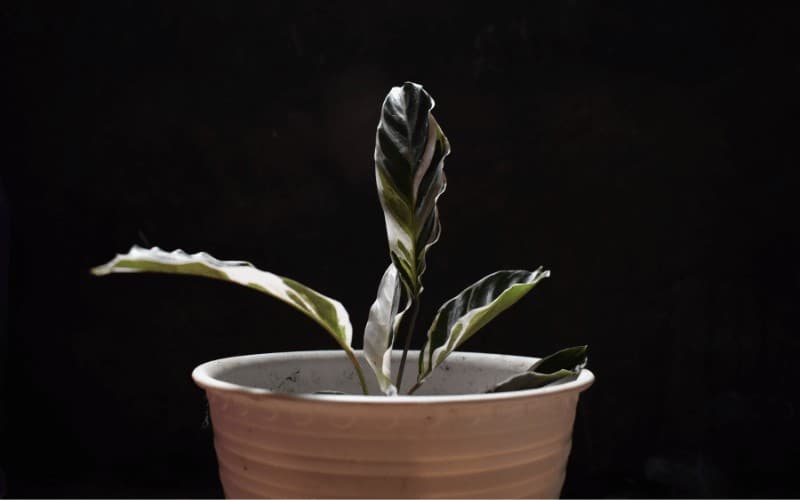
Fusion white as it is popularly known by houseplant lovers. It comes with a fantastic marbling of white and green on the foliage with a bright purple underneath it.
The fusion white plant will be most appealing to those that love showy plants. Hence, this plant is recommended for you.
Nevertheless, ensure it is safe in a place with an acceptable degree of humidity, as well as exposed to a bright indirect sunlight.
20. White Tiger (Calathea albertii ‘White Tiger’)
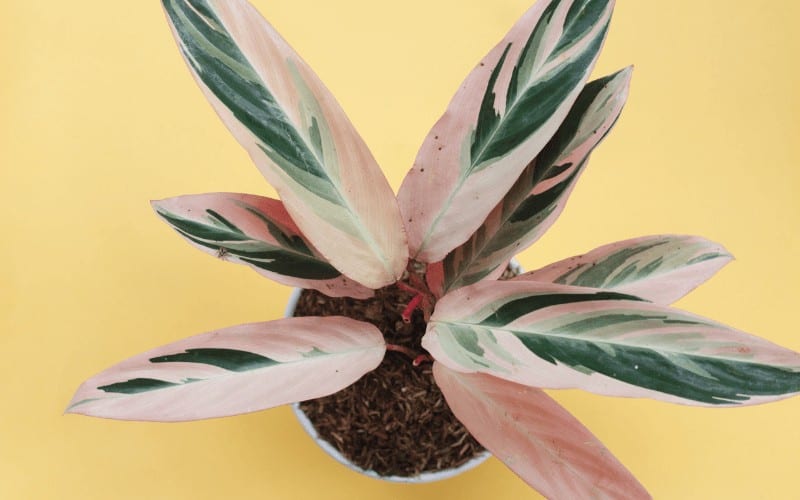
The white tiger as it is commonly called, possesses a charming white pattern in the shape of waves on the dark green leaves.
To enable splash of colors, you can blend it with the other varieties on this list. That is white tiger Calathea for you.
It can easily be paired with other Calathea plant types to give you a very beautiful and attractive varied colors. Meanwhile, like others, it requires humidity and bright indirect sunlight.
21. Beauty Star (Calathea ‘Beauty Star’)
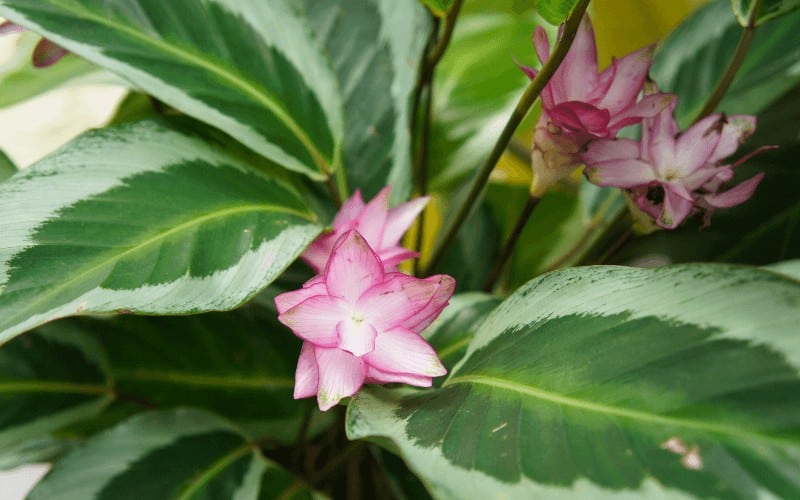
If, like most people, you are so attached to anything green, then you will love the Calathea Beauty Star. You will so worship it, as its foliage features a bright green feathering from the center that flows towards the dark green ends of the leaves.
Just ensure it is kept at a place with high humidity level, and ensure it is exposed to a bright indirect sunlight.
There are so many varieties of the Calathea plant, hence, having mentioned the top 21 types, let’s briefly highlight some of the other types of the plant that may interest you:
Other types of calathea that are worth mentioning include:
- Misto, otherwise known as Calathea ‘Misto’
- Calathea rotundifolia, originated from the Greek word, ‘Kalathos’ meaning ‘Basket’.
- Calathea Louisae
- Calathea Lutea
- Calathea Burle Marx, named after Brazilian landscape designer, Roberto Burle Marx
- Calathea Picturata
How To Care For Calathea Plants
Below are the key things to take note of in order to protect your Calathea plants from destruction, while also ensuring their attractiveness remains adorable:
Calathea Light Requirement
It doesn’t matter the type, the entire Calathea family are mostly attractive when put under shades, whether it is a complete or partial shade.
Talking about its light, though, it may likely survive under bright lights, but indirect lightning is the best recommended light setting for it.
Temperature Requirement
For the fact that Calathea is a tropical plant, it will require a warm indoor temperature of about 60–80-degree Fahrenheit and humidity. Mind you, it doesn’t require unnecessary heavy watering.
Watering Calathea Plant
As regards the aforementioned, Calathea needs water, and thrives with a wet and dry watering method. In other words, it needs to be watered thoroughly.
After that, hold on for some moments so as to ensure the top inch of soil dries before repeating the trick (watering again). Ensure the soil is not soggy.
Also, beware of excessive watering as it could likely invite all kinds of pests including spider mites, Aphids, and Scale.
Again, beware of low level of humidity as it can lead to situations in which the tips on the leaves dry up, edges turn brown, curling leaf, and eventually turning brown.
Feeding Calathea Plant
There is the need for constant fertilization. You will want to fertilize your calathea plant at least every two weeks, and let it be done during late spring to early fall, with a partial strength water-soluble houseplant fertilizer.
Soil Needs
Calathea plant, no doubt, survive most when planted in well-drained fertile soil. For a rich soil base mix 25% extra peat moss to bagged houseplant potting soil to make an original soil mix.
Propagating Calathea
When propagating the Calathea, it is advisable you do it by division when repotting. Thickened tubers is clearly defined on the roots.
So, it is most attractive when the tubers have one or two leaves. Then, you plant the divisions in a pot 2 inches underneath the soil surface in a rich, well-draining soil like the aforementioned. Ensure the soil remain a bit moist and warm.
Frequently Asked Questions
How many types of Calathea are there?
Calathea has about 300 cultivars, which are spread across several bunches of different species of this genus.
How do you identify a Calathea?
Calathea can be easily identified by its leaves. The plant usually has dark-green leaves with bright pink stripes and bright-green feathering.
Can Calathea grow in low light?
Yes, calathea plants thrives in low light; however, some aspects can make it somewhat difficult for them.
What is the easiest calathea to care for?
Calathea lancifolia, also known as Rattlesnake Plant, is considered the easiest calathea plant to care for.
How often should you water a Calathea?
We recommend watering your calathea plant every 1 to 2 weeks. Remember to let the soil dry out half way between watering. Also, water less often in lower light and more often in brighter light.
Can you propagate Calathea?
Yes, you can propagate calathea, and the easiest way to propagate the plants is by division.
Calathea houseplant thrives better when it's divided and repotted each year in early spring before its growth period starts. However, calathea cannot be propagated by stem cuttings.
Why is a Calathea called a prayer plant?
Calathea is called a prayer plant because its leaves fold together at night, looking like a pair of praying hands. The majority of types of prayer plants have variegated leaves, which adds to their overall interest.
Conclusion | Different Calathea Varieties
We have fully listed out some types of calathea plants, and their brief features. The ball now rests in your court to choose from anyone of them and make your home a more colorful and attractive place.
It’s worth noting that calathea comes nearly 300 varieties, so there are still more that we didn’t mention in the article.
Related Articles
- Types Of Indoor Succulent Plants
- Ginkgo Tree Varieties
- Types of Palm Plants
- Types of Rainforest Plants
- Types of Snowball Bushes
- Types of Palm Trees In Florida




